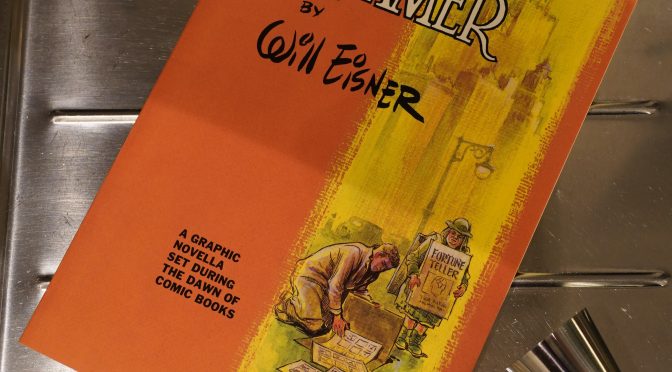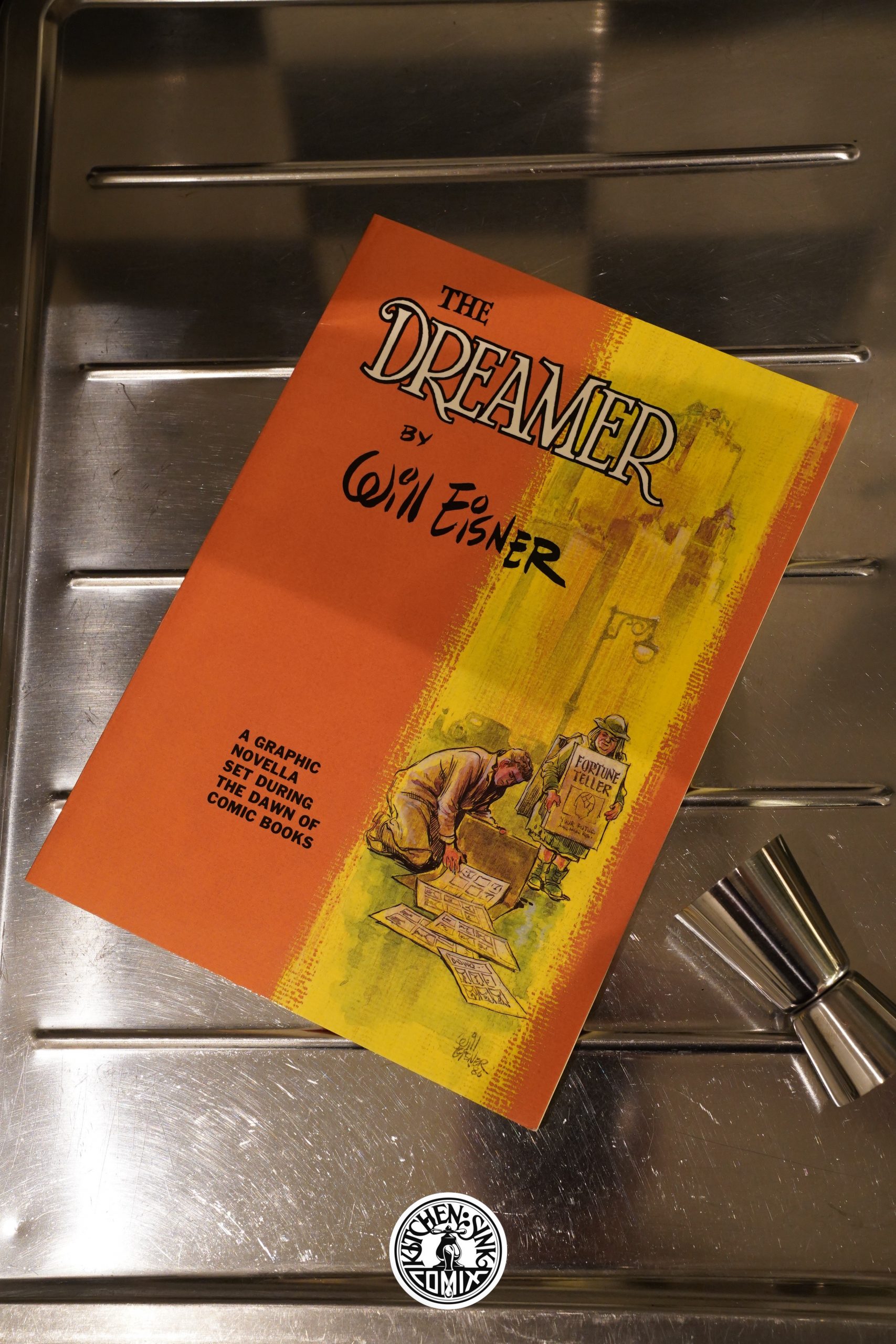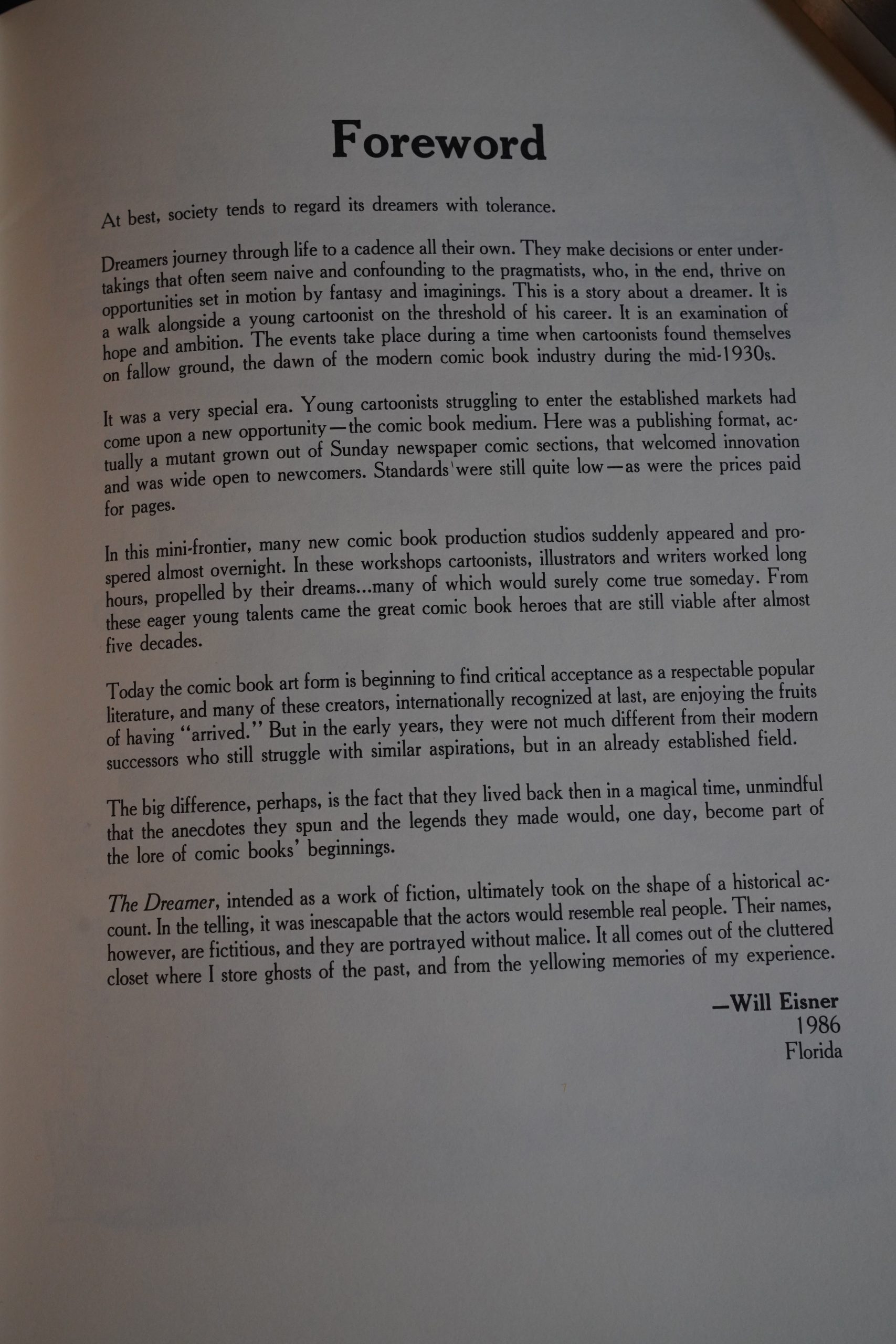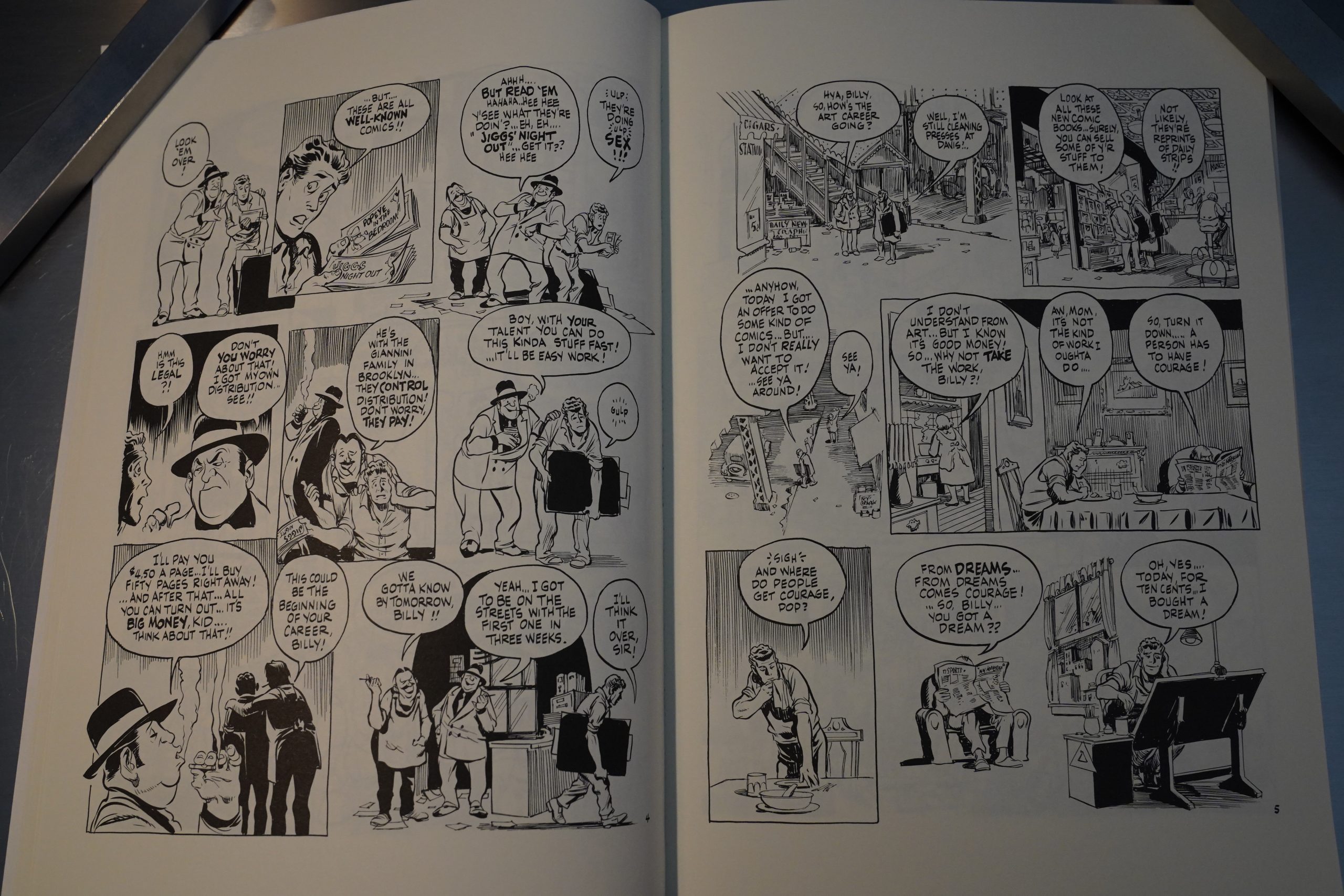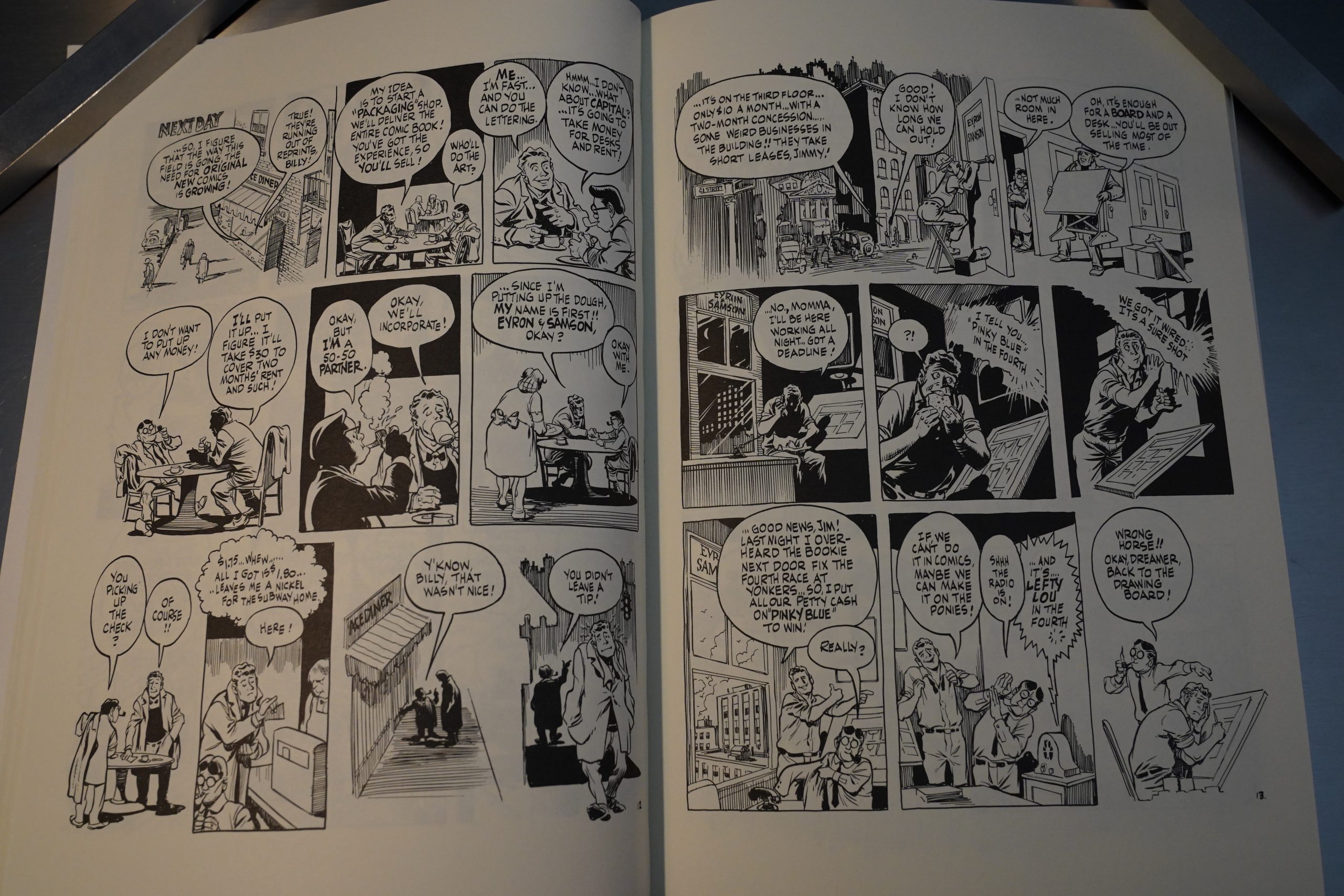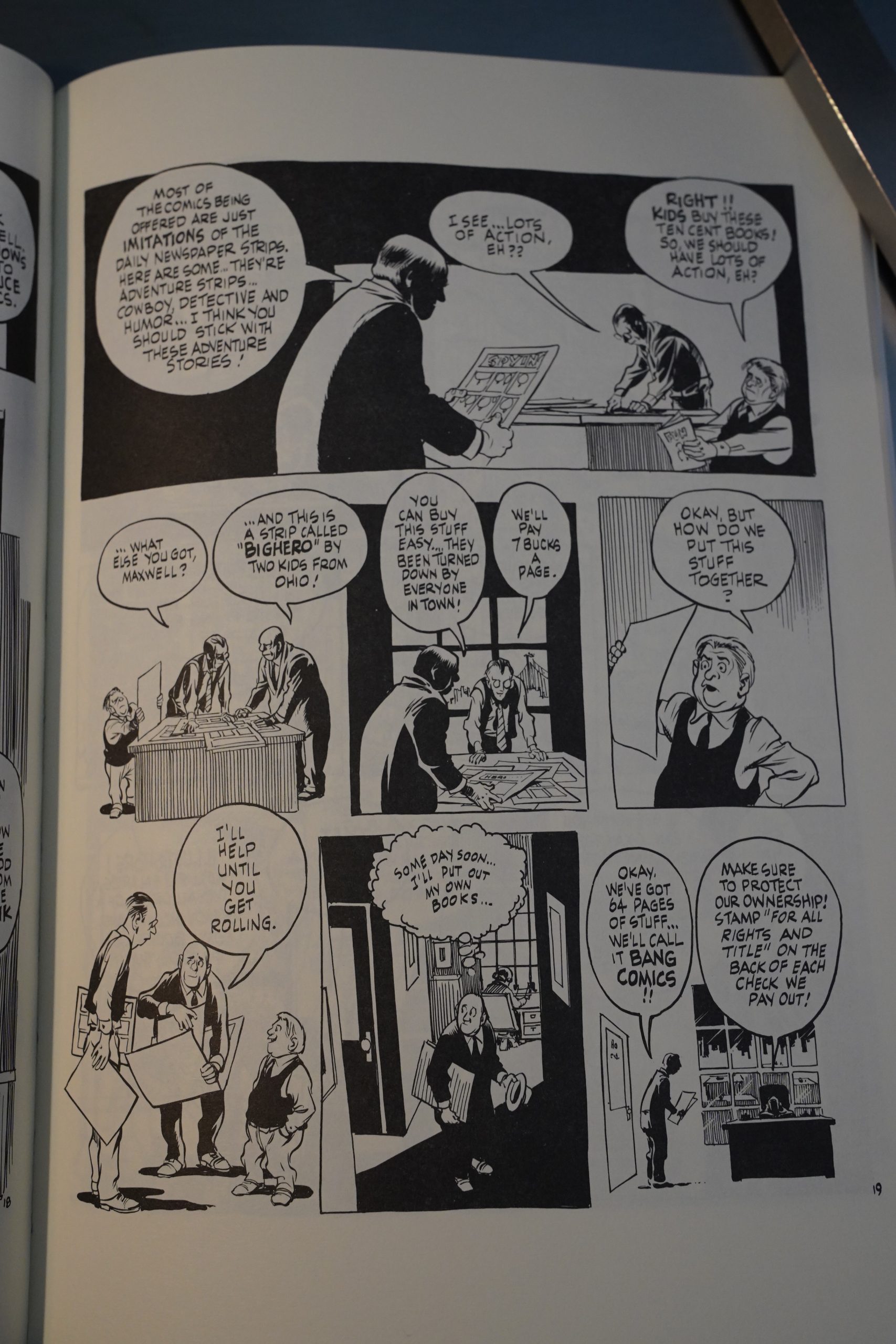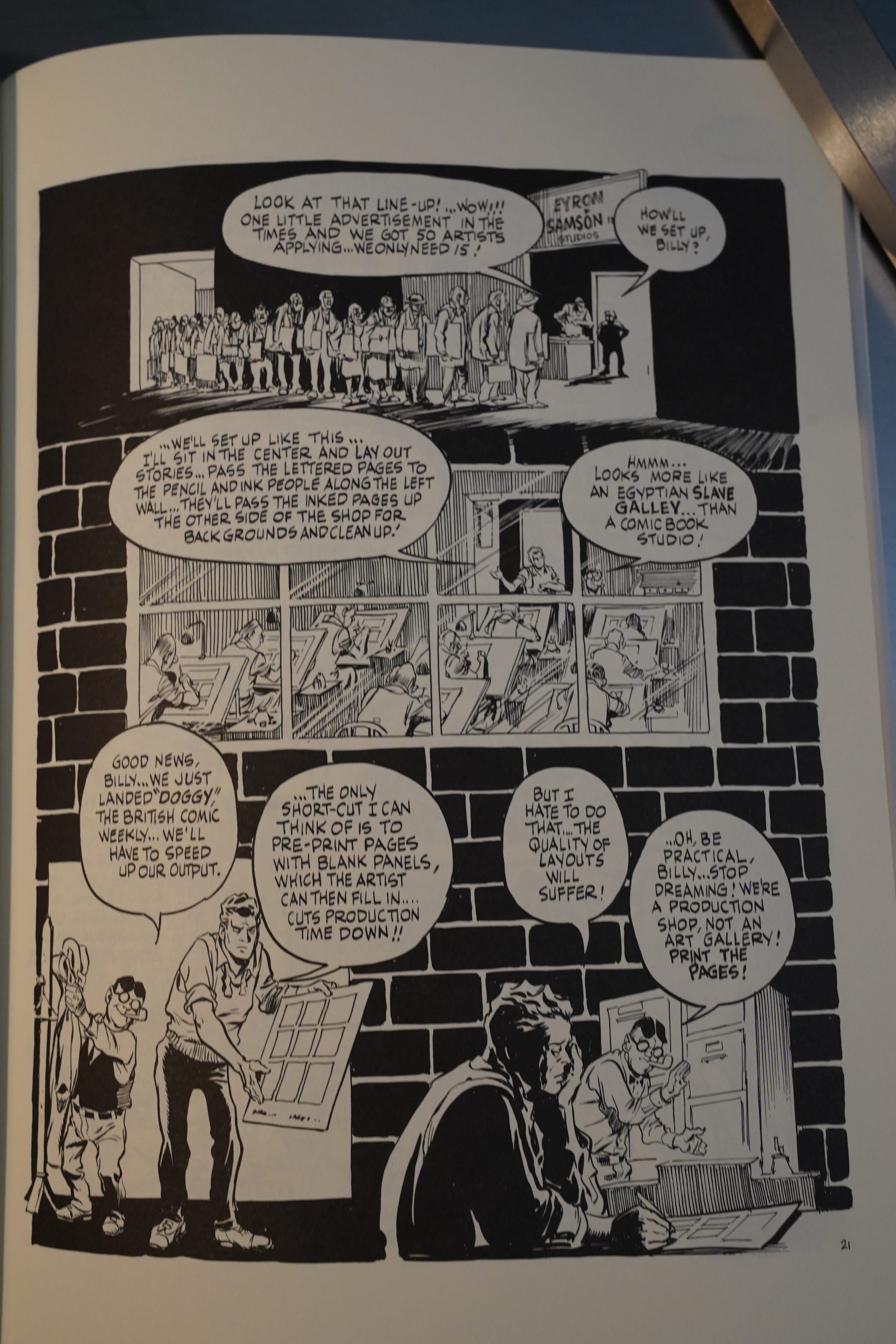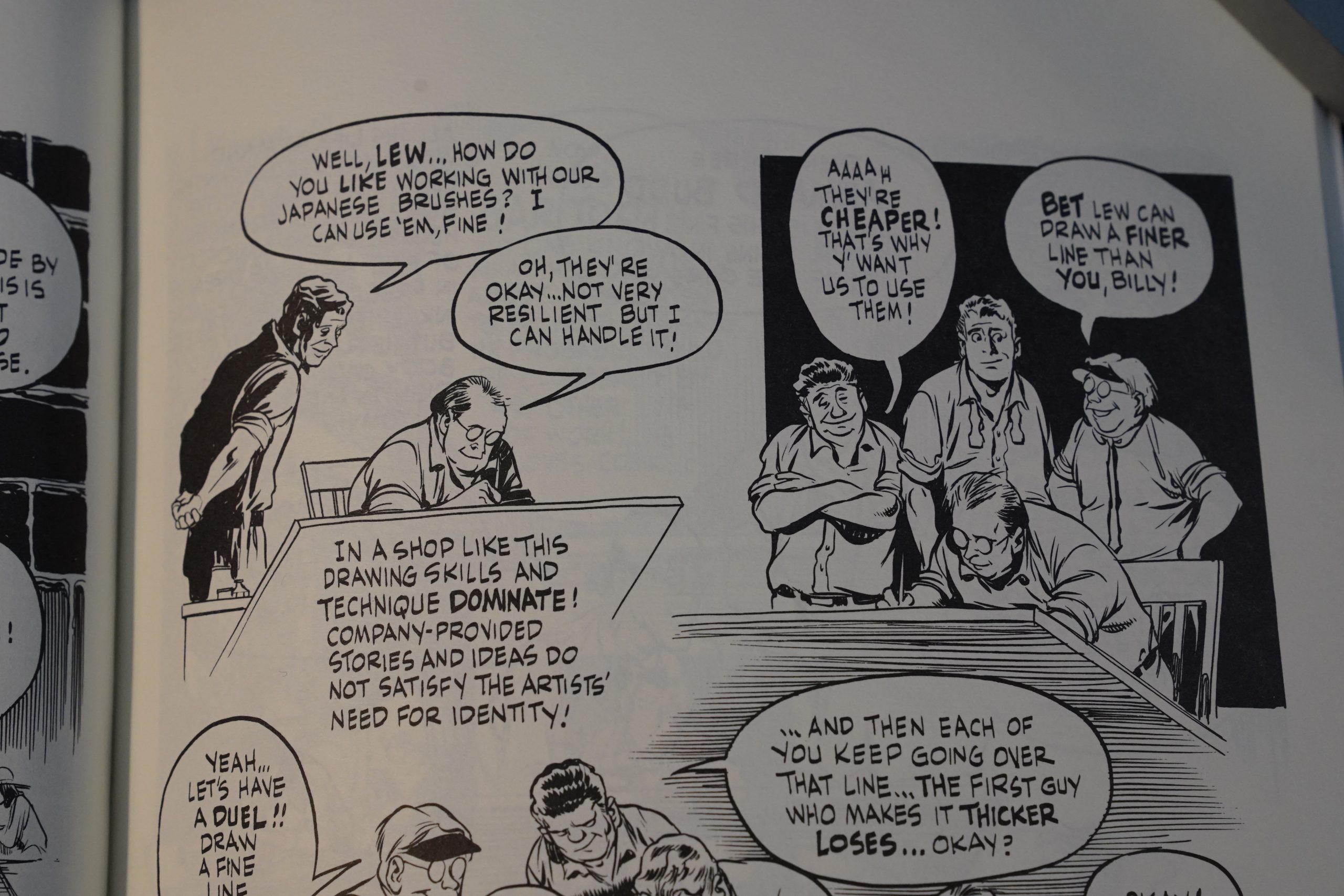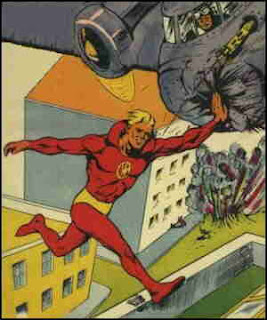The Dreamer (1986) by Will Eisner
I get that back in 1986, nobody knew how to sell comics to a literate audience — but this book is obviously trying to appeal to people who quite liked A Contract With God (which had, finally, been quite a commercial success). So they go with a thinner format… on very white paper instead of a solid book paper stock… indifferent typography… and instead of a brown, serious cover, they go with… orange an pee yellow.
I mean, c’mon.
C’mon.
Eisner explains that he set out to do fiction, but it ended up being anecdotes from the start of his professional career instead (I’m paraphrasing slightly).
And some of these anecdotes are kinda interesting — like when the mobster wanted him to do porn comics. He turned them down, because… he’s such a dreamer.
Yes, that’s the leitmotif here, and he sticks it in so many times that it’s wince inducing.
(Ibid.) I also don’t understand why he’s insisting on not using people’s real names — Eyron & Samson instead of Eisner & Iger. It surely can’t be because he thought anybody’d be offended, because he treats all of his close associates with loving care. Nothing untoward is revealed or even hinted at.
The least successful parts of the book are when he diverges from telling his own story: Here’s when DC buys Superman off of Siegel & Shuster. (I’ve got a decoder ring.)
The book doesn’t really have that much of a flow — it’s just a bunch of anecdotes, and the storytelling is really, really clear.
Eisner & Iger set up a production line for pumping out comics in the 30s — and despite calling it a slave galley, he portrays himself as a softie, while Iger cracks the whip (but gently). I think people who worked for Eisner at the time disputes this slightly.
There’s a whole section where he summarises a few of the people who used to work for him in a very sentimental way. Here’s “Lew Sharp”. Let’s see if you can guess who that is:
“I can use ’em, fine!” “Bet Lew can draw a finer line than you”.
Yes. Yes, you guessed it. Lew Sharp is : Lou Fine:
Either at about age two or in his early teens, Fine’s left leg became crippled by polio.
This is about Eisner creating a knock-off of Superman as Fox Feature Syndicate’s Wonder Man:
DC sued and they lost money on that project.
And then Eisner’s offered the Spirit newspaper insert, and the book is over.
It’s not that this is a bad book — but it’s so unstructured, and much of it just feels… dishonest? He’s all that portraying himself, a (by all counts) shrewd businessman, as a hapless dreamer, and that makes for a raised-eyebrow reading session.
But I mean, it’s fine? But there’s a reason it didn’t make a splash like A Contract With God did, and it’s not all about the design choices for the cover.
Gary Groth writes in The Comics Journal #119, page 7:
The elements of Eisner’s Spirit that were
acceptable in that context have become an
Obstacle to the serious aims in Eisner’s more
“mature” work. The sentimentality that
• •humanized” the Spirit stories was offset by the
humor: in Eisner’s new work there is no room
for humor. only sentimentality. When all this
Hollywood schmaltziness is placed in a serious,
indeed stridently “literary” endeavor, it mere-
ly becomes obnoxious.
Eisner’s previous “graphic novella,” ne
Dreamer. is less stilted and mechanistic and
more engaging than The Building, but its failure
is on a grander scale given its potential historical
significance. lhe Dreamer is Eisner’s recollec-
tions of the early years of the comics industry
and his participation in it, told in narrative form;
it is an act of memory and, perhaps more im-
portantly, an opportunity to reconcile, with
historical reality. It is a failure in my view
because one of the essential prerequisites of a
memoir, even one told in fictional form as The
Dreamer is, is a ruthless self-examination of the
author’s own role, and whenever such self-
examination becomes crucial to the truthful
realizÆtion of the work, Eisner fudges or evades
or coyly deflects the reader’s attention through
clever narrative sleights of hand. Graham Greene
once wrote that there is a chip of ice in every
writer’s heart, by which he meant not that a good
writer must be without compassion, but that he
must be merciless in his pursuit of the truth.
Eisner is not.
Let’s get the predominantly literary quibbles
out of the way first. The theme of the book is
the role of the dreamer in the cultural milieu
of the comics industry circa approximately 1938
or ’39. This is the first problem. Why does an
autobiographical work have to have a Theme at
all, and why as tendentious a theme as this, one
that is shoved in the reader’s face as often as
possible? In case the title itself isn’t heavyhanded
enough, characters refer to dreams or dreamers
40 times in this 46-page story. Theme is one of
those facets of literature the young student learns
in a freshman literature course, which helps to
simplify the complexities of good writing by the
use of categorization. (This undoubtedly makes
multiple choice tests easier for teachers to put
together). I have a feeling that someone once told
Eisner that every book must have a theme,
because Eisner cannot do without a theme
however supererogatory it may be.
This brings up another difficulty; the title of
the book is The Dreamer, singular, but the story
is clearly about dreamers, plural. We may infer
that the title refers to the Eisner character since
he is centerstage and the character most often
referred to (and most often referring to himself)
as a dreamer. but the story stresses the univer-
sality of dreamers, which makes the choice of
a singular rather a plural an odd, even egoistic
one. This could be dismissed as a sloppy over-
sight, but for the fact that the sloppiness extends
to the inconsistent and confused use of the theme
throughout the book. As I’ve pointed out, the
words dream or dreamer are used 40 times in
the book. They are usually applied to artists and
usually as terms of approbation even when they
are used sneeringly by a more pragmatic,
“realistic,” disgusted, or frustrated character
(usually a businessman) to describe an artist
(usually Eisner) whose motivations aren’t wholly
economic or materialistic. 0K. , this uould be
trite and cliched, but at least it would be consis-
tent. But, the terms are also used to describe
rapacious publishers, therefore universalizing the
term to refer not merely to aspiration or idealism,
but to naked greed and wanton ambition as well.
This robs an already precariously sentimental and
romanticized title of what meager moral
resonance it might have.
In one panel a printer who has previously been
portrayed as an avaricious opportunist screams,
“Publishing! I’ll be a publisher! .. .Yeah, now that
is a dream I’ve always had.. (This is Donald
Harrifield who represents Harry Donenfeld, who
bought out a small comics publisher and started
National Periodical Publications (DC) in 1937).
The comics publisher who has been squeezed out
of business by Harrifield casually shrugs,
“Publishing was just a dream.” Previously, the
dreamer is consistently portrayed as a noble out-
sider, alienated by the vulgarities of commerce.
Earlier in the story there is this exchange:
Eisner’s father: “A person has to have
courage!”
Eisner: “(sigh) And where do people get
courage, pop?”
Eisner’s father: “From dreams.. .from
dreams comes courage!”
And apparently, from dreams comes inbecility,
vulgarity, and greed, though these polar defini-
tions Of the dreamer are never investigated within
the story. This could have been an opportunity
to explore the differences in motivation between
such dreamers (if Eisner is going to insist that
they’re both dreamers with dreams) and draw-
ing conclusions, or at least asking questions if
drawing conclusions is too much to ask for, as
to the values of the respective dreamers. But, this
isn’t done. The cover and title clearly refer to
Eisner: the cover painting is of a young Eisner
with an art portfolio with a fortune teller in the
background (get it?). The printer-cum-publisher
who refers to himself as having a dream is con-
sistently portrayed as a loveable cartoon rogue,
flailing about humorously and exaggeratedly
whenever seized by a frenzy of greed. This is
as penetrating a portrait as Eisner paints of such
a man. One doesn’t have to see men like this as
harshly as I do, as accomplices in the murder
of an artform, as having surrendered their cons-
ciences to the lure of economic gain, to be of-
fended by this lame, morally vacant portrayal.
Yup.
Stuart Hopen writes in The Comics Journal #116, page 79:
The Dreamer, like Eisner’s other
recent work, does not provoke
dreams. Nor is it mainstream fare
that massages deeply held cultural
values. Here, Eisner joins Harvey
pekar and Art Spiegelman in using
blatantly autobiographical material
as the basis for a graphic story. But
The Dreamer is coated by a thin
veneer—a very thin veneer—of fic-
tion. The protagonist’s name is
Billy EyrOn. He is the co-owner of
a comic sweatshop where we
meet artists such as Jack King, a
short, tough, cigar-smoking street
kid, and Lou Sharp, a superb
draftsman who was crippled by
polio. This renaming Of familiar
people creates an odd distancing
effect, a curious mirror image of
the effect created by Art Spiegel-
man’s metaphorical use of animals.
(Eisner might have portrayed
dreamers as mice, realists as cats.
A character named Vincent Rey-
nard, a publisher, could have been
a fox.)
This renaming also creates an air
of intimacy. Those familiar with
the history of comics will recog-
nize most of these characters and
events. Surely, no one else will.
The intended audience seems to be
the industry itself. For those with
insider’s knowledge, the story
resonates with folklore charm.
Take for example a contest between
Eyron and Sharp in •which they
compete over the tracing Of a
straight line. This is the stuff Of
legends to insiders—a clash
between giants Of the medium. To
the general public, it would seem
trivial. And for those who know
the medium, Eisner takes us back
in time with a g,rave Of his brush,
using a crisp, clean line reminis-
cent of his earlier uork, and a
seven-to-ten panel per page layout
that’s reminiscent of old pulp
comics. There is a sense that
Eisner is sharing intimate family
secrets, like a patriarch sitting
down with his nouveau riche pro-
geny, reminding them of their
The first comics we see in The
Dreamer are pornographic works
that pirate famous syndicated
characters, an obvious reference to
the scandalous eight-pagers of the
time. It is a powerful suggestion
that, at the time of its birth, comics
was a gutter medium, an undeserv-
ing and illegitimate brother to
newspaper strips. The first major
comics company we see, Harri-
field, began with minimal aspira-
tions. A printing company is in
trouble because its pulp producing
customers are going out of busi-
ness. The company reasons that if
they publish comics and make only
enough to cover printing cosß, they
will still have made a bottom line
profit.
Robert Haining writes in The Comics Journal #121, page 25:
One could forgive much of this if The Dreamer
had the accuracy of a work of non-fiction. While
I am no expert, I know Of one instance where
Eisner misrepresents a situation by omitting im-
portant facts. When the Victor Fox character
wants Eisner to do a blatant rip-off of Super-
man and Eisner expresses reservations, his part-
ner, the Jerry lger character, brushes aside his
doubts, stating that he thinks that Fox is a “big
shot.” Eisner describes the debate with lger
much differently in Panels #1, “We discussed
it, and lger said, ‘Well, there’s really not much
we can do about it. It’s his magazine and he’s
asking for this and we’ll do it for him.’ I wor-
ried about it, but lger made a very convincing
argument, which was… that we were very
hungry. We needed the money badly [emphasis
Eisner’s].” Eisner does not bring this up at the
time the Fox character approaches them since
they have to use methods to speed up produc-
tion. By leaving the financial situation out of the
book, Eisner gives us the impression that lger
was blinded by greed when he was trying to be
practical. It is not enough that writers give us
the facts. Facts must also be presented in the pro-
per context. This is what Eisner fails to do in
this case.
Dale Luciano writes in The Comics Journal #117, page 53:
An extremely pleasant surprise was
Kitchen Sink’s second notable release,
Will Eisner’s The Dreamer, which sub-
titles itself ‘ ‘A Graphic Novella Set Dur-
ing The Dawn of Comic Books.” This is
a charming, modest, nostalgic account of
the formation of the comic industry.
As told by an artist of substantial repute
who played a key role in the creation of
this distinctively American industry, it
takes on the significance of a historical
document. It is also transparently
autobiographical, so it has a wonderful
lived through this—can you believe
it?” quality, and we have the privilege of
watching one Of the medium’s masters
look back and reminisce about his own
role in history. I found it enormously
entertaining.
Did I use the word “nostalgic?” The
Dreamer evokes the image Of an industry
founded by quick-buck entrepreneurs furi-
ously intent On exploiting a lucrative fad
which, many of them suspected, might
quickly slide into the same extinction as
the pulps. Among its virtues, : The
Dreamer captures a sense of this indus-
try’s divided soul. Its chief product, fan•
tasy, was cranked out by a stable of
dedicated, eccentric, variously talent art-
ists, all of them conscious of their own
exploitation at the hands Of publishers.
Eisner has no special axe to grind. While
he does not deny the crassness Of the
shysters and opportunists who float in and
Out Of the story, they are depicted, Often
with real comic grace, as archetypal
American hustlers and con artists. And
the artists are depicted, with affection and
respect, as distinctive American types as
well—men and women struggling to hold
on to the dream of “making a living as
an artist” while they sell their skills as
craftspeople.
On a different and more personal level,
The Dreamer is an autobiographical
excursion into the past, revealing how
Eisner remembers himself living through
the episodes depicted and how he feels
about those years. There are so many
wonderful images in The Dreamer that
beautifully express the trials of the cen-
tral character, “Billy.” In One sequenfe,
we watch him. timid and fearful Of deep-
ened involvement with a young woman
whom he’s too shy to kiss goodnight, walk
forlornly and alone through the rain. In
both the writing and art, Eisner captures
a powerful sense of Billy’s simultaneous
confusion, humiliation, and determina-
In another—an episode based on the
well-known Captain Manel plagiarism
suit—ue watch Billy struggle with the
dilemma Of whether to maintain his in-
tegrity and tell the truth on the witness
stand and lose $3,000 in the process, or
lie. (Yes. he learns that integrity can be
expensive.)
The Comics Journal #121, page 37:
He pulls this same Stunt with The Dreamer by
claiming that it isn’t an autobiographical work,
but a fable. How does Jones justify this seman-
tic revisionism? ‘It’s a work of wry, affectionate
commentary on the human condition, set in a
particular historical moment and utilizing
caricatures based on real people.” How this
relieves Eisner of an obligation to historical
accuracy and artistic truthfulness is not exactly
explained. Jones’ contempt for historical
accuracy and artistic forthrightness is further
demonstrated by his contention that “Eisner’s
own background is of no consequence. He can
rewrite whatever he wants, so long as it’s fic-
tionally effective.” No “essential prerequisites”
here, not even a respect for history; any writer
can distort an obviously historical work as long
as it’s “fictionally effective.” For Jones, anything
goes.
Jones acts as though The Dreamer were a
thriller or an adventure Story in which I found
a plot hole; even purely fictional work should
be held to some standard of historical accuracy
to the extent that it uses history; an autobiography
by its very nature has to be held to a higher
standard.
The idea that The Dreamer is not an auto-
biographical account is pure nonsense. It is worse
than nonsense, it is sheer deception. Eisner
himself in the introduction to the book writes,
“The Dreamer, intended as a work of fiction,
ultimately took on the shape of a historical ac-
count.” The book, Eisner continues, came out
of his own “experience.” Eisner is quoted on the
back cover as saying that The Dreamer ‘ ‘is in-
tended as a kind Of graphic historical novel set
in the primordial dawn of the comic book
industry,” the operative word being historical.
In Jones’ own cliche-ridden review Of the book
in Amazing Heroes, he wrote: “Beautiful, funny,
bittersweet, and illuminating, this is the sen-
timental gentleman of comics, the master of the
intimate human story, fondly recalling the early
days of the funnybook. Few people experienced
those days like Will Eisner, and nobody could
relate them half as well.”
But, as it turns out, Jones doesn’t care if Eisner
related his experience in those days or not since
Eisner “can rewrite whatever he wants, so long
as it’s fictionally effective.” And since, accord-
ing to Jones, The Dreamer was based upon
Eisner’s experience, how can Jones write that
“Eisner’s background is of no consequence?” My
central disappointment with The Dreamer is
precisely that Eisner has frittered away his
knowledge and understanding Of the seminal
period of comics publishing, not to mention fail-
ing to take advantage of his unique perspective
as both exploiter and exploited.
Huh. I guess The Dreamer was a big think in the columns of The Comics Journal?
Dwight Decker writes in Amazing Heroes #121, page 52:
Meanwhile, out in the great Amer-
ican Heartland, Wisconsin’s Kitchen
Sink Press has published Will
Eisner’s The Dreamer, blurbed as
“A Graphic Novella Set During the
Dawn of Comic Books.” The comic-
book sized squarebound softcwer is
$5.95 for 46 black and white pages
—and it’s it. Eisner, one of the
undisputed grand masters of the
comics form, has written and drawn
a thinly disguised autobiographical
account of what it was like to be
breaking into comic books in the late
’30s. The early history of the comic-
book industry has been written any
number of times in any number of
dull, dry accounts, but in a sense
this is the first time it’s been sent to
music. Through Eisner’s viewpoint
character, “Bill Eyron,” the modern
reader gets a sense of what itfelt like
to be living in that Far-away time and
working in the field.[…]
The
dream motif is unfortunately more
obtrusive than evocative, and seems
almost calculated to make “Eynn”
appear unusually senstive and
gifted, noble even, and meant for
better things than cranking out cheap
thrills in an artists’ sweatshop.
But Eisner did such a splendid job
in evoking a time, a place, and a
feeling, that I’m willing to forgive
him for a certain amount of self-
justification. Quite simply, The
Dreamer belongs on the shelf of
anyone with an interest in the
Golden Age of Comic Books. In
lightly fictionalized form, this is the
story of hoov it all began.
Fred Milton writes in The Comics Journal #122, page 39:
When commenting upon The Dreamer, I feel
Groth is really nasty. Since this fairy tale
obviously has some personal overtones, Groth
demands that it ought to present a critical note
to the position Eisner as a person held in the
whole process described in the story. This is
irrelevant. Whether Eisner was a saint, a victim
or an accomplice in the handling of the comics-
business at the time is totally beside the point
in this story-concept. Eisner is “merely” tell-
ing yet another fairy tale. And he is in his perfect
right to do so! Why shouldn’t he? Is it illegal to
have an opinion about the mechanisms in society
if you are not a saint yourself? On the contrary!
The person who may have the clearest view of
the weaknesses and imperfections in society may
very well be the person who commited all the
blunders and mistakes himself—or at least
imagines what it would feel like commiting
them… Eisner may very likely have comprom-
ised some Of his ideals concerning the comic
book industry just to get along and make ends
meet. We all do. That does not mean, that you
deprive yourself of having a qualified opinion
about how things ought to have been instead , nor
of having all the rights to express it, even in
retrospect.
I have met Mr. Eisner personally at two
occasions. He has all the ways of a modest and
accepting man, very sympathetic and well-
balanced and not at all a person bursting with
self-assuredness or holy perfection. Most likely
Mr. Eisner has acquired his opinions and visions
through a life filled with problems and personal
misjudgment. That’s how you become a good
author in any medium. The current comics scene
is filled with storytellers who acquire most Of
their inspirations from their colleagues and
predecesors, from TV and films—but not from
real life. Eisner may prefer to use his life learn-
ing to tell miry tales—that’s his privilege. He does
not have to use realistic story structures and an
autobiographical means to express himself. They
will exist somehow anyway when he presents his
creative efforts. Maybe storytellers who use
anthropomorphic figures, myself included, have
it a little easier. No one demanded that Carl
Barks be autobiographical when he wrote his
fairy tales. But the strength of his “themes” were
well-founded in his life experience which he
gathered doing a myriad of things before he
thought up his first duck story. When he did
write, he used all the things he had learned: the
unfair treatment from employers, personal
frustration and aggression from numerous situa-
tions, the negative effects Of things outside the
control of Mr. Middleman. Barks was never
overtly autobiographical and yet in his fairy tales
autobiographical material seeps into his best
stories. A similar judgment may be used upon
Will Eisner even though he preferéd to draw
human characters instead of ducks.
Gary Groth replies:
For what I hope is the last time: The Dreamer
is an autobiography, not a fairy tale. Will Eisner
thinks it ‘s an autobiography, and I think it ‘s an
autobiog raphy.
Garard Jones writes in The Comics Journal #121, page 30:
This becomes painfully clear when Groth
moves from The Building to The Dreamer. His
critique seems based upon two points: First, that
an “essential prerequisite” of any memoir “is a
ruthless self-examination Of the author’s own role
lin the events recounted],” and that Eisner fails
to do this and fails at “pursuing tough value
judgements” concerning the role Of the “ex-
ploiters” who published comics in the late ’30s.
And, second, that Eisner was wrong to attach
a theme (dreaming) to an autobiographical book,
and that he put that theme across very muddily,
to boot.
Here, even more than before, Groth is trying
to hammer Eisner’s work into the pattern Of his
Own aesthetic dogmas, and throwing it out when
it refuses to fit. The Dreamer isn’t intended as
a factual record, as a political statement, or as
a serious literary autobiography; and, frankly,
I don’t see that it has any obligation to be such.
It’s a bittersweet, humorous remembrance of a
time through which the author lived, wrapped
around some amused meditations on the
greatness and the pitfalls of dreaming.
In arguing against the utility Of a theme in
autobiography Groth states, “Theme is one of
those facets of literature the young student learns
in a freshman literature course,” then bestows
his judgement upon Eisner with magnificent con-
descension: “I have a feeling that someone once
told Eisner that every book must have a theme,
because Eisner cannot do without a theme
however supererogatory it may be.”
The presumption Of this comment (even
granted that it’s probably offered with an attempt
at wry humor) is remarkable. It suggests that
Eisner’s themes are not his own, that his desire
to play with ideas and the repeated patterns of
human experience in the course Of his stories
springs not from his own heart but from
something that “someone once told [him].” Thus
it fits in very nicely with (Broth’s earlier implica-
tion that Eisner’s plots and subject matter were
cynically lifted from Hollywood for commercial
reasons. It flows from his basic thesis that Eisner
should have been a socially-committed realist but
sold out. Thus do most Of the points in this criti-
que go back to a starting point which, I main-
tain, is unsupportable.
I’ll agree with Groth that Eisner does pound
on the “dreaming” theme a little too often.
Uh huh.
Gary Groth answers Jeet Heer writes in The Comics Journal #128, page 48:
Notice, first, that my major criticism Of Will
Eisner’s The Dreamer, to the effect that he sugar-
coated the grotesque moral circumstances of the
comics industry, is not challenged by Heer,
though there is much tap-dancing around the no-
tion that there is a standard Of truth to which
works of autobiography should be held.
Apparently, Rousseau can get away with out-
right lying because his autobiography “gives us
a strong sense of [his] inner life” and because
“Lies a man tells about himself can be as reveal-
ing as any number Of facts.” Well, hell, why not?
And Eisner can get away with ignoring the deeper
social and moral issues Of his autobiography be-
cause he “gives us a sense Of how he looks at
the world.” As far as “lenient criteria” go, these
qualify beautifully. However, Malcolm Cowley
does not benefit from such “lenient criteria.” Ap-
parently, even though Cowley certainly “gives
us a sense of how he looks at the world,” this
does not exempt him from adhering to an un-
stated but more exacting standard Of historical
accuracy. Even the Old lies-reveal-as-much-as-
facts criterion can’t seem to get Cowley Off the
hook (no pun intended). It’s all very confusing,
but after reading Heer’s letter carefully, I think
we can divine a rule of thumb: members of the
leftist-commie-pinko-fag axis do not deserve the
benefit of Heer’s capriciously applied “lenient
criteria” of historical accuracy.
I, on the other hand, grant “lenient criteria”
neither to middle-of-the-road liberals (such as,
say, Elia Kazan), nor to Communists and fellow
travelers — nor to anyone else. I believe an un-
yielding truthfulness is practically indispensable
to the form (Kay Boyle and Robert McAlmon’s
Being Geniuses Together is a good example),
though I’ll concede that there can be compen-
sating pleasures that make an inaccurate or im-
precise autobiography worthwhile. Nonetheless,
in Out of Step. a book Heer apparently accepts
as gospel, Sidney Hook writes this about auto-
biography:
..1 have sought to avoid the cardinal sins
of the autobiographer. nese consist in re-
constructing rhe past, denying or covering
up the foolishness and error of previous
years, and casting rhe author in an alto-
gether heroic mold. nis is more often done
by artful omissign and emphasis than by
Wagrant invention. Wish fulfillment often
selectively alters memory.
This is as perfect a description of Eisner’s fail-
ing in The Dreamer as I could possibly hope to
read. Its relevance is positively eerie.
The accusation that I do not apply my strict
criteria for historical accuracy to authors I ap-
prove of (i.e. Cowley) is entirely false because
it rests upon the presumption that the passage
I quoted by Cowley in Joumal #121 was false and
that I knew it to be false at the time I quoted it.
On the contrary, I believe no such thing, and will
draw readers’ attention to the fact that Heer does
not even attempt to disprove the passage I quoted.
Mr. Heer conveniently confuses the particular
with the general. If I understand his point, he
is twing to claim that because I quoted a passage
by Cowley to support my description Of Ameri-
can intellectual life in the late ’30s, I am therefore
endorsing every jot and titter Cowley wrote, and
am therefore guilty Of not applying the same high
standard to Cowley that I imposed on Eisner. My
only claim is that the specific passage I quoted
is historically accurate. Cowley may very well
have revised the extent of his commitment to Stal-
inism, but this allegation is irrelevant. I would
be just as happy to quote a passage I felt was
historically accurate by Eisner despite my mis-
givings about the historical and artistic truthful-
ness Of The Dreamer.
OK, I think I’ll just stop there, because it just goes on and on. Groth’s article, mildly criticising Eisner, turned out to be The Most Controversial Article In Comics Journal History, apparently. But he was right, of course.
This is the eighty-second post in the Entire Kitchen Sink blog series.
